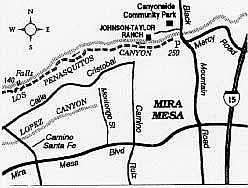 Facebook
Facebook
 X
X
 Instagram
Instagram
 TikTok
TikTok
 Youtube
Youtube
Crickets sing, cicadas buzz, and bullfrogs groan. A sparrow hawk alights upon a sycamore limb, then launches with outstretched wings to catch a puff of sea breeze moving up the canyon. A cottontail rabbit bounds across the trail and stops to take your measure with a sidelong stare. Los Peñasquitos Creek, rejuvenated by the El Niño-driven storms, slips silently through a sparkling pool and darts noisily down multiple paths in the constriction known as "the falls."
Los Peñasquitos Canyon
Despite the noose of suburban development tightening around it, Los Peñasquitos Canyon Preserve still retains its gentle, unselfconscious beauty. The preserve's 3000 acres of San Diego city and county-owned open-space stretch for almost seven miles between Interstates 5 and 15, encompassing much of Los Peñasquitos Creek and one of its tributaries -- Lopez Canyon.
Down at the east end of the preserve, off Black Mountain Road, stands the refurbished 1862 Johnson-Taylor adobe ranch house. A section of the house appears to be the remains of an 1824 adobe cottage erected by Captain Francisco Maria Ruiz, a Commandant of the Presidio of San Diego.
Farther afield, hikers, joggers, and equestrians have the run of the preserve. Mountain bikers are welcome too, but they must stick to the main 6-mile-long dirt road along Los Peñasquitos Creek. Probably the best summer hike (or bike ride) in the preserve -- certainly the one with the most shade -- is the ramble toward the falls from the east, 6.5 miles round trip.
Start at the parking lot on the west side of Black Mountain Road, opposite Mercy Road. From there, follow the main dirt road hugging the base of the canyon's steep, chaparral-covered south slopes. Mile posts along the roadside help you gauge your progress. You wind in and out of dense oak woodlands (draped with poison oak in places) and across meadows dotted with small elderberry trees, now in fruit.
At the three-mile marker the road winds up onto a chaparral slope in order to detour a narrow, rocky section of the canyon. Near the top there's a wide spot, with racks for securing bikes, and a foot trail descending north to the falls area, where the stream has carved a narrow constriction into the bedrock. Even at this late date, water still cascades through here. Polished rock ten feet up on either side testifies to its maximum depth. The outcroppings of greenish-gray rock, just in this one small area, are a type called Santiago Peak volcanics; they're typical of the metamorphosed volcanic rock found on Santiago Peak in the Santa Ana Mountains. Be very cautious if you choose to clamber about on the water-polished slabs and boulders -- and keep an eye out for rattlesnakes.


Crickets sing, cicadas buzz, and bullfrogs groan. A sparrow hawk alights upon a sycamore limb, then launches with outstretched wings to catch a puff of sea breeze moving up the canyon. A cottontail rabbit bounds across the trail and stops to take your measure with a sidelong stare. Los Peñasquitos Creek, rejuvenated by the El Niño-driven storms, slips silently through a sparkling pool and darts noisily down multiple paths in the constriction known as "the falls."
Los Peñasquitos Canyon
Despite the noose of suburban development tightening around it, Los Peñasquitos Canyon Preserve still retains its gentle, unselfconscious beauty. The preserve's 3000 acres of San Diego city and county-owned open-space stretch for almost seven miles between Interstates 5 and 15, encompassing much of Los Peñasquitos Creek and one of its tributaries -- Lopez Canyon.
Down at the east end of the preserve, off Black Mountain Road, stands the refurbished 1862 Johnson-Taylor adobe ranch house. A section of the house appears to be the remains of an 1824 adobe cottage erected by Captain Francisco Maria Ruiz, a Commandant of the Presidio of San Diego.
Farther afield, hikers, joggers, and equestrians have the run of the preserve. Mountain bikers are welcome too, but they must stick to the main 6-mile-long dirt road along Los Peñasquitos Creek. Probably the best summer hike (or bike ride) in the preserve -- certainly the one with the most shade -- is the ramble toward the falls from the east, 6.5 miles round trip.
Start at the parking lot on the west side of Black Mountain Road, opposite Mercy Road. From there, follow the main dirt road hugging the base of the canyon's steep, chaparral-covered south slopes. Mile posts along the roadside help you gauge your progress. You wind in and out of dense oak woodlands (draped with poison oak in places) and across meadows dotted with small elderberry trees, now in fruit.
At the three-mile marker the road winds up onto a chaparral slope in order to detour a narrow, rocky section of the canyon. Near the top there's a wide spot, with racks for securing bikes, and a foot trail descending north to the falls area, where the stream has carved a narrow constriction into the bedrock. Even at this late date, water still cascades through here. Polished rock ten feet up on either side testifies to its maximum depth. The outcroppings of greenish-gray rock, just in this one small area, are a type called Santiago Peak volcanics; they're typical of the metamorphosed volcanic rock found on Santiago Peak in the Santa Ana Mountains. Be very cautious if you choose to clamber about on the water-polished slabs and boulders -- and keep an eye out for rattlesnakes.
